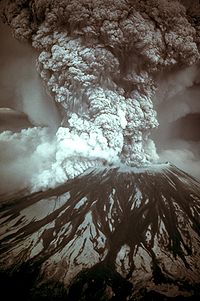Mt. St. Helens eruption
| 1980 eruption of Mt. St. Helens | |
|---|---|

Photograph of the eruption column, May 18, 1980.
|
|
| Volcano | Mount St. Helens |
| Date | May 18, 1980 |
| Time | 8:32 am PDT |
| Type | Plinian, Peléan |
| Location |
Skamania County, Washington, U.S. 46°12′1″N 122°11′12″W / 46.20028°N 122.18667°W |
| VEI | 5 |
| Impact | Approximately 57 deaths, about $1.1 billion in property damage; caused a partial collapse of the volcano's flank, deposited ash in 11 states and five Canadian provinces |

Map of eruption deposits
|
|
On May 18, 1980, a major volcanic eruption occurred at Mount St. Helens, a volcano located in Skamania County, in the state of Washington, United States. The eruption (a VEI 5 event) was the only significant volcanic eruption to occur in the contiguous 48 U.S. states since the 1915 eruption of Lassen Peak in California. However, it has often been declared as the most disastrous volcanic eruption in United States history. The eruption was preceded by a two-month series of earthquakes and steam-venting episodes, caused by an injection of magma at shallow depth below the volcano that created a large bulge and a fracture system on the mountain's north slope.
An earthquake at 8:32:17 a.m. PDT (UTC−7) on Sunday, May 18, 1980, caused the entire weakened north face to slide away, creating the largest landslide ever recorded. This allowed the partly molten, high-pressure gas- and steam-rich rock in the volcano to suddenly explode northwards toward Spirit Lake in a hot mix of lava and pulverized older rock, overtaking the avalanching face.
An eruption column rose 80,000 feet (24 km; 15 mi) into the atmosphere and deposited ash in 11 U.S. states. At the same time, snow, ice and several entire glaciers on the volcano melted, forming a series of large lahars (volcanic mudslides) that reached as far as the Columbia River, nearly 50 miles (80 km) to the southwest. Less severe outbursts continued into the next day, only to be followed by other large, but not as destructive, eruptions later that year.
...
Wikipedia
